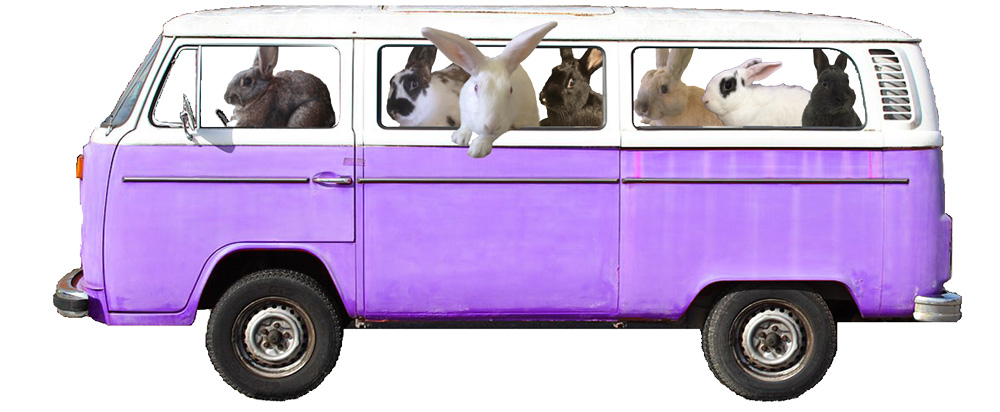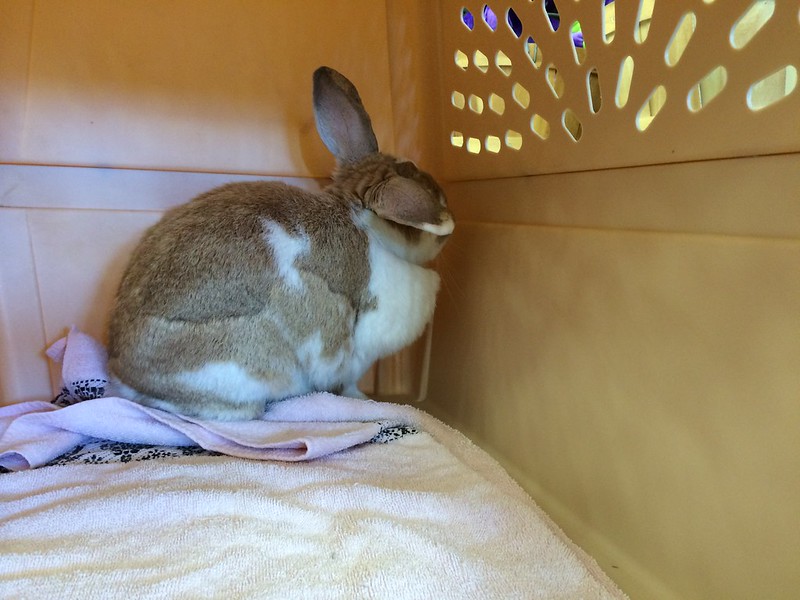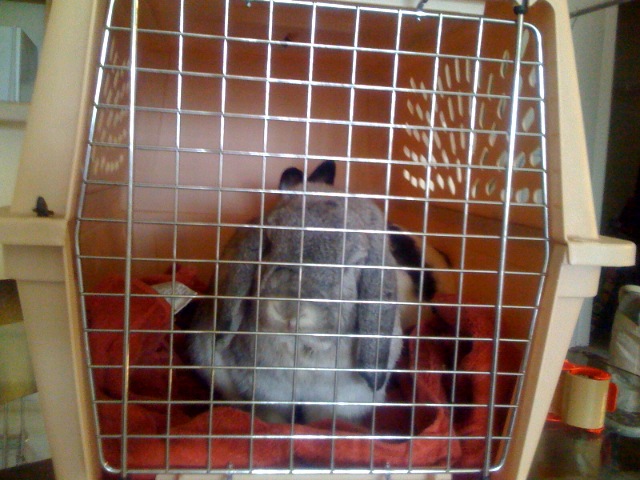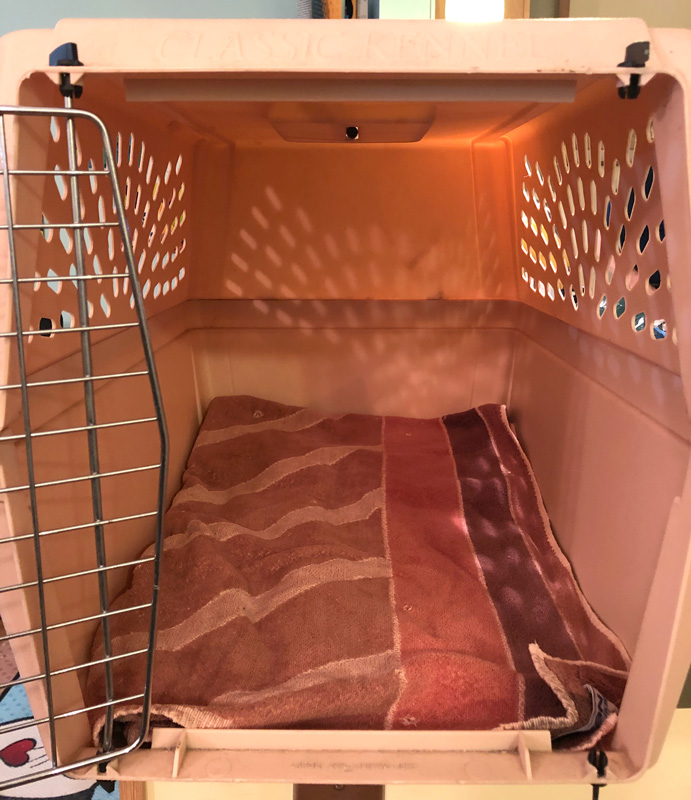
Come Saturday morning, Moraea, Finnegan, and I head out on an errand. When I open the car door, both bunnies joyfully hop right in. They ride with their noses pressed to the windows, excited to view the passing scenery. Arriving back home, they jump down from their little car seats and cheerfully follow me inside.
OK, that’s pure fantasy. As much as I’d love to bring my little fuzz-faces with me wherever I go, they wouldn’t like it; not one bit.
Pssssst! If you like the Bunny Bus design featured above, you can shop our Bunny Bus Collection of mugs, t-shirts and more on Zazzle!
Travel and Stress
Most bunnies find travel stressful. There are lots of reasons why that might be:
- Everything is unfamiliar — not knowing what to expect
- Being taken away from the place they know as home, where their food and familiar hiding places are
- Vibrations and centripetal forces — “invisible” agents acting on their bodies when riding in a moving vehicle
- Being confined or restrained — imagine being tied up, or being placed in a locked room
- Noise, in vehicles that are not well sound-insulated
- Lack of choice
Even dogs and cats, who aren’t as vulnerable as rabbits (see also; predators, not prey) often find vehicular travel scary. So it should come as no surprise if your bun doesn’t think it’s fun.
There may be some bunnies who don’t mind car travel, but they’ll certainly be in the minority. If you want to know how your long-eared lad feels about it, observe him closely next time he travels. Here are some things to look for.
| Rabbit State | Behavior |
|---|---|
| Relaxed, normal | Sleeping, or casually exploring; will take a treat if offered |
| Slightly stressed | Lying still but not sleeping; very attentive to sounds and smells; eyes may be wider than normal |
| Stressed | Breathing faster than normal; face is tensed; won’t take treats (“Tensed” is tough to define, but if you are very familiar with your rabbit you will start to notice how their face looks when they are relaxed, vs. when something is upsetting them.) |
| Very Stressed | Body very flat, ears back, motionless, eyes wide, or trying desperately to escape, or attacking |
| Information thanks to G Bradbury, Behavioural Problems in Rabbits: A Clinical Approach, 5M Publishing Ltd. 2018, p.84 Diagram 3.7 | |

Importantly, “just sitting there” doesn’t necessarily mean your rabbit is at ease. All animals — including humans — respond to perceived threats in one of three ways: fight, flight, or freeze.
The third one is the hardest to recognize. Also referred to as “shutting down,” freezing is an attempt to look dead, not attract attention, or avoid confrontation. Sometimes you have to be very observant and look for the signs in the table above to distinguish stress from calm. This is especially true when your friend is confined and can’t run away even if he wanted to.
Should You Avoid Travel?
Because of the potential stress involved, my personal policy is to only transport my bunnies when it’s necessary:
- When I move to a new home, either permanently or for an extended stay
- When they need to see a vet
- When boarding while I’m on vacation
- When meeting a new potential family-member bunny, if we don’t have a neutral space in our home
- Occasionally to serve at a rescue event to help other rabbits get adopted
Though it’s tempting, I don’t bring my rabbits:
- When I go on vacation
- When a friend or co-worker suggests I bring them somewhere so they can meet them
- On day trips

My rationale: the rabbit doesn’t get to choose. Even if it’s not traumatic for him, it will at the very least be annoying. He had plans of his own for that day — or, at least, expectations — which I have cancelled without his permission. For most dogs, a chance to share the adventure is a treat worth the tradeoff. Dogs evolved to travel and hunt with people. Domesticated rabbits were bred to stay put until harvested. Rabbits are homebodies.
These are just a few considerations to keep in mind. The final decision about when it is or isn’t appropriate to travel with your bunny is up to you.
Whatever you decide, you probably won’t be able to avoid it altogether. Here’s are a few things you can do to make car travel the best experience possible.
Have a Great Crate

It’s important to make sure your whisker-nosed travel companion will have a comfortable seat on the ride. A pet carrier is a much better and safer option than a lap ride.
It doesn’t have to be the Grand Hyatt, but you want it to at least be a solid Holiday Inn. It should be big enough for her to go in and turn around, and not be bumping her head on the ceiling. You also want her to be able to lay down and stretch out. If yours isn’t this big, get a bigger one.
Although most of my puff-tailed passengers are so freaked out during travel that they just lay there, panting, some do not take the experience lying down. Rather, they will gnaw their way through it. I’ll never forget the day we adopted our Monty from the municipal shelter. Half way through the ten minute drive home, he had chewed a hole in the cardboard carrier big enough for him to squeeze through! Fortunately I had both hands free to help keep him contained until we got home.
This is an example of a fight or flight reaction, rather than just a freeze. Because cardboard and soft-sided carriers can fall victim to these sharp-toothed escape artists, I prefer to use hard plastic crates.
The floor of the crate should be padded, so it’s comfy to lie on. You also want enough traction so furry feet won’t slip and slide around in it. I always put a big folded bath or beach towel in the crate. Big towels provide good cushioning. Their bulk makes them less likely to get all scrunched up in one corner from bunny digging or from the motion of travel.
Lastly, I strongly recommend you use a travel carrier that allows for the bunny to get in and out by themselves. This will give you the option to crate train your rabbit, which eliminates the additional stress of their being picked up when entering or exiting the crate.
Consider Crate Training
Crate training simply means getting an animal to go into a pet crate or travel carrier and happily stay there. It’s very common for dogs. Many people put their dog into a crate when they go to bed or when they leave the house. The dog is comfortable and has everything he needs (toys, blanket, access to food or water). The owner can rest assured their dog will happily chill out and most dogs won’t soil the crate.
I don’t recommend that you crate your rabbit to alleviate housetraining or bunstruction worries. A travel crate is far too small a place for a bunny to spend a lot of time. An exercise pen or large hutch with room to run around is more appropriate. But I do advocate crate training to solve the rabbit transport problem.
As noted in a previous post, crate training for travel is one of the key reasons I think bunnies should be trained. It has been a huge a stress reducer for both me and my rabbits.
In my next post, I’ll take you through the steps to crate train your rabbit. In the meantime, here’s a few things you can do to get ready.
Preparing for Crate Training
If you’ve never trained your bunny before, check out my introduction to training post . Have some fun teaching your rabbit some simple stuff while teaching yourself to train! Once you are comfortable with the basic mechanics, try target training your bun. Target training is very helpful to enable crate training.
Habituating to the Crate
If your bun already has a history with the travel crate, it probably isn’t a happy one, due to the stress of travel we already discussed. She’ll probably have about as much enthusiasm for going near the crate as I have for drinking rum and Coke. (Even though that dark episode in my life is ancient history, I still can’t contemplate that drink.) That doesn’t necessarily mean you can’t use the same crate. Just keep in mind that it will be a factor in how fast you can expect her to progress in her training. You may have a lot of unpleasant memories to cancel out with good ones.
Even if she’s never seen the crate before, your rabbit may not be that keen on getting near it, or going into it. Rabbits aren’t big fans of enclosures. They get a little nervous about becoming trapped in the space, and in this case, let’s face it, it’s justified!
To get your bunny more comfortable with the crate, leave it sitting out where she can access it, with the door open or removed. Don’t forget that nice thick towel for padding and traction.
Let the crate sit there all day every day for a while. Sooner or later she’ll probably get curious enough to go inside. How often or soon she does this will depend on her level of distaste for the crate. For example, at first she might wait until you’re out of the room to investigate it. The more times she interacts with it and nothing bad happens, the more her fears will subside.
Caution: if the crate door is not removed, make sure it’s secured in the open position. Getting trapped inside by a door that accidentally shut will be a trauma that sets your bunny back!
 The Fluffy Tail of This Blog Post
The Fluffy Tail of This Blog Post
Travel can be stressful for anybody, but it’s particularly so for a helpless, confined passenger who would prefer to be snoozing in her favorite corner at home. Be mindful and consider carefully before traveling with your rabbit. And to help make it easier on both of you when you do need to transport her, try crate training your bunny.